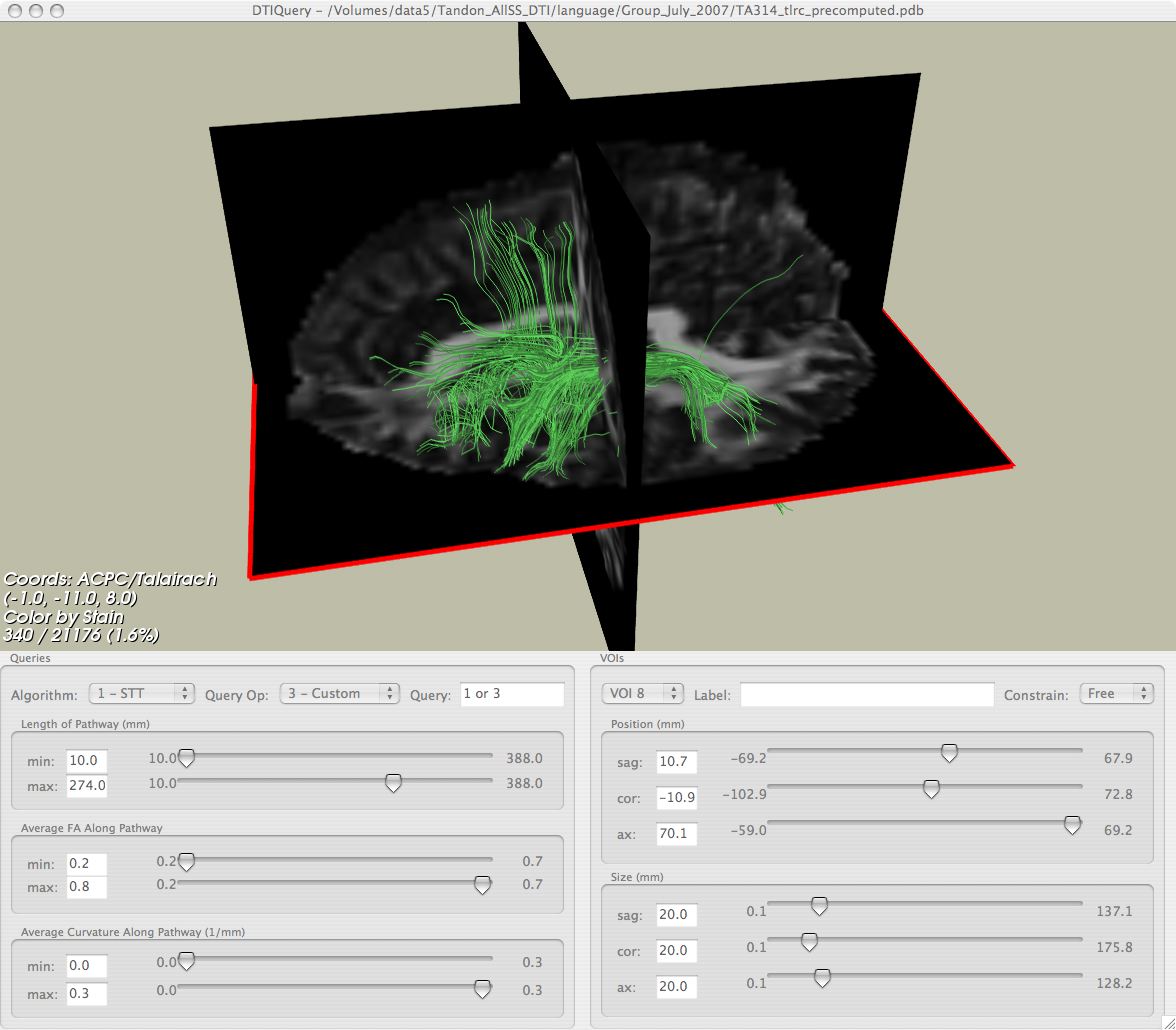Beauchamp:ProcessDiffTensImgData: Difference between revisions
(New page: These steps show how to process DTI data acquired on the UT Philips 3T scanner == Create a 3d+time DWI BRIK from DICOM files == '''1) The first step is to reconstruct the raw diffusio...) |
(No difference)
|
Revision as of 14:47, 9 April 2008
These steps show how to process DTI data acquired on the UT Philips 3T scanner
Create a 3d+time DWI BRIK from DICOM files
1) The first step is to reconstruct the raw diffusion-weighted volumes ...
Set the subject identifier variable. This is just an example: you can use any string.
set ec="TA309"
Make the .BRIK and .HEAD files from raw data stored in the subdirectory {$ec}_060807 (your directory name will be different)
You need to know number of dynamics (34), number of slices (70), and repetition time (9543.7 ms)
The dynamics, slices and repetition time are all available in the Philips .PAR file
The output is an AFNI image file called {$ec}_DMaps+orig
to3d -session . -epan -prefix {$ec}_DMaps -time:tz 34 70 9543.7 alt+z ../{$ec}_060807/ax_dti_high/DICOM/IM_* ../{$ec}_060807/ax_dti_high/DICOM/00000001/IM_*
Correct DWI for Movement and Align Volumes to High Resolution MRI
2) The second step is to correct diffusion volumes for movement, and coregister the data to the space of the high resolution anatomical volume
This step registers each diffusion weighted volume to the skull-stripped anatomical volume, in this case called {$ec}avaganatSS+orig
The output is an AFNI image file called {$ec}DWIREGtoSSanat and a textfile containing the transformation parameters called {$ec}DWIREGtoSSanatXform
3dAllineate -base {$ec}avganatSS+orig -source {$ec}_DMaps+orig -prefix {$ec}DWIREGtoSSanat -verb -warp affine_general -EPI -cost mutualinfo -1Dfile {$ec}DWIREGtoSSanatXform -master {$ec}_DMaps+orig
Compute the Diffusion Tensor in Scanner Space
3) The third step is to compute the diffusion tensor image, which will be used for deterministic fiber tracking
This AFNI program 3dDWItoDT computes the tensor from the diffusion volumes acquired with different gradient orientations
The gradient orientation table is stored in a textfile called DWGradientVectors.txt, and is listed below the tensor computation command
The gradient orientations are specific to the Philips 32 direction diffusion encoding scheme (high angular resolution) with the gradient overplus option
The output is a file called {$ec}_Tensors.nii.gz, which is in single-subject space and in alignment with the high resolution anatomy
3dDWItoDT -prefix {$ec}_Tensors.nii.gz -automask -reweight -max_iter 10 -max_iter_rw 10 DWGradientVectors.txt {$ec}DWIREGtoSSanat+orig'[0..32]
The x,y,z gradient orientations (contents of DWGradientVectors.txt)
-0.532, -0.465, -0.707
-0.532, -0.465, 0.707
0.658, -0.753, 0.000
-0.670, -0.226, -0.707
-0.254, -0.660, -0.707
-0.028, -0.707, -0.707
0.382, -0.595, -0.707
0.678, -0.201, -0.707
-0.670, -0.226, -0.707
-0.340, -0.686, -0.644
0.246, -0.725, -0.644
0.481, -0.520, -0.706
0.686, -0.340, -0.644
-0.737, -0.424, -0.526
-0.519, -0.674, -0.526
0.511, -0.680, -0.526
0.674, -0.519, -0.526
-0.753, -0.658, 0.000
-0.737, -0.424, 0.526
0.674, -0.519, 0.526
0.424, -0.737, 0.526
0.674, -0.519, 0.526
-0.664, -0.382, 0.644
-0.752, -0.657, 0.055
-0.340, -0.686, 0.644
0.245, -0.725, 0.644
0.658, -0.753, 0.008
0.686, -0.340, 0.644
-0.752, -0.657, 0.049
-0.013, -0.707, 0.707
0.658, -0.753, 0.012
0.706, -0.047, 0.707
Talairach Transform the Aligned Volumes
4) If you've transformed your skull-stripped anatomical volume to Talairach or MNI space, you may apply this transform to the individual diffusion-weighted volumes
This allows you to conduct fiber tracking in a standardized space to allow for comparisons between subjects.
To do this use the @auto_talairach script which is distributed with AFNI
The output is a BRIK of all the diffusion weighted volumes each in Talairach space with 2mm isotropic resolution
@auto_tlrc -apar {$ec}avganatSS_at+tlrc. -input {$ec}DWIREGtoSSanat+orig. -dxyz 2 -verb
Compute the Diffusion Tensor in Talairach Space
5) Now we compute the tensor on the Talairach transformed diffusion volumes
The output is a tensor file similar to the file produced in step 3, except that it is in standard Talairach space not single-subject space
3dDWItoDT -prefix {$ec}_Tensors_at.nii.gz -automask -reweight -max_iter 10 -max_iter_rw 10 DWGradientVectors.txt {$ec}DWIREGtoSSanat_at+tlrc'[0..32]
Compute FA Volumes and Whole-Brain Fiber Pathways
6) The last step is to compute fractional anisotropy (FA) volumes and whole-brain fiber pathways with DTI Query v1.1b
DTI Query 1.1b is available at: http://graphics.stanford.edu/projects/dti/dti-query/
The command below presumes you have installed DTI Query in your /Applications directory
First we do computations on the data in single-subject space
The output files are fa.nii.gz and precomputed.pbd, which are the FA volume and fiber pathways respectively
They are renamed here to have the subject identifier pre-pended and the label orig
/Applications/DTIQuery_v1.1macintel/dtiprecompute_cmd -t {$ec}_Tensors.nii.gz -o . -f 0.15 -a 45 -d 2.0 -s 4.0 -minL 5.0 -maxL 300.0 -i EULER
mv fa.nii.gz {$ec}_orig_fa.nii.gz
mv precomputed.pdb {$ec}_orig_precomputed.pdb
Next we do computations on the data in standardized Talairach space
The output files are fa.nii.gz and precomputed.pbd, which are the FA volume and fiber pathways respectively
They are renamed here to have the subject identifier pre-pended and the label tlrc
/Applications/DTIQuery_v1.1macintel/dtiprecompute_cmd -t {$ec}_Tensors_at.nii.gz -o . -f 0.15 -a 45 -d 2.0 -s 4.0 -minL 5.0 -maxL 300.0 -i EULER
mv fa.nii.gz {$ec}_tlrc_fa.nii.gz
mv precomputed.pdb {$ec}_tlrc_precomputed.pdb
Interactively Visualize Fiber Pathways
Now you are ready to load your processed FA and fiber pathway file in DTI Query for interactive tractography!
